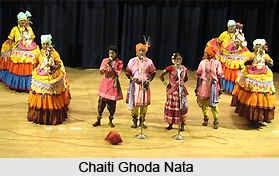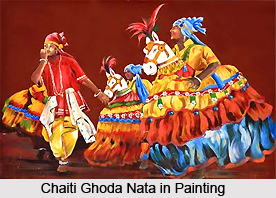 Chaiti Ghoda Nata is a simple form prevalent among the fishermen community of coastal Odisha (formerly known as Orissa) who are popularly known as Keuta (Kaivarta). The festival, termed as Chaiti Ghoda is held for a whole month beginning from the full moon in Chaitra that is. from March to April to the full moon in Baisakh i.e. from April to May.
Chaiti Ghoda Nata is a simple form prevalent among the fishermen community of coastal Odisha (formerly known as Orissa) who are popularly known as Keuta (Kaivarta). The festival, termed as Chaiti Ghoda is held for a whole month beginning from the full moon in Chaitra that is. from March to April to the full moon in Baisakh i.e. from April to May.
It is said that Lord Rama had presented a horse to the boatman who had helped him to cross the river Saraju during the period of his Vanavas. Hence, they worship horse which is considered to be the tutelar deity of the community.
Performance of Chaiti Ghoda Nata
The dance is deeply ingrained in the Shakti cult. An integral portion of this dance drama is enacted by the character of a horse. Therefore, it is called Ghoda Dance. An image of horse is improvised out of bamboo and cloth, complete with a head, body and tail but without legs. The dancer enters into the cockpit of the hollow body and hangs it at his waistline to give the illusion of a rider on the horse, complete with straps, performance are done in an arena without a green room.
The time is during celebrations of the annual festival of Baseli worship. As the local goddess Baseli is believed to be horse-headed, the dummy-horse dance becomes a necessary part of invoking her.
 Most troupes have six members. As for example three actors, two percussionists on dhol (drum) and jodi nagara, or twin kettledrums, and a mahuri i.e. wind instrument player. All are professionals go to different villages on invitation. While the actors belong to the fishermen`s community, the musicians are Harijans.
Most troupes have six members. As for example three actors, two percussionists on dhol (drum) and jodi nagara, or twin kettledrums, and a mahuri i.e. wind instrument player. All are professionals go to different villages on invitation. While the actors belong to the fishermen`s community, the musicians are Harijans.
The drama usually contains only two characters, the Rauta and his wife Rautani. The Rauta is the main singer and interpreter. His wife is usually played by a man and more recently by women. After the invocation, they enact episodes from Kaibarta gita or `Fishermen`s Song`. This is a religious text on the community`s origins. The Rauta, in between songs and intermittent dancing, narrates and interprets the events.
Nowadays, the performers also take up mythological stories to enlarge their repertoire. In between the episodes, humorous situations such as domestic quarrels provide entertainment to spectators. Sometimes, the couple indulges in battles of wit in the form of questions and answers. The performance continues till late night.
The Kaibarta Caste is the sole performer of this dance form. The dance form with its varied mythological associations and accompaniments is interesting to watch.



















